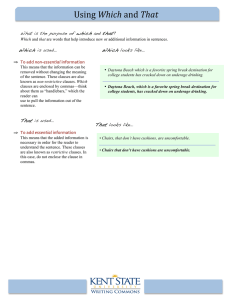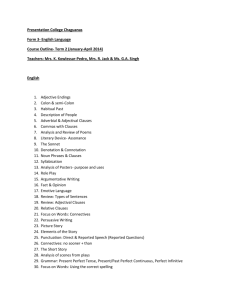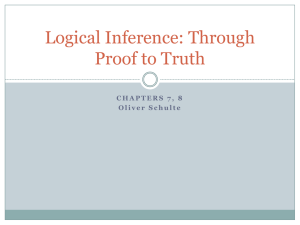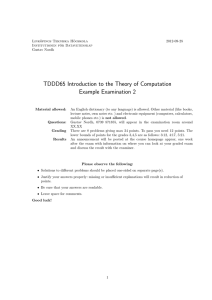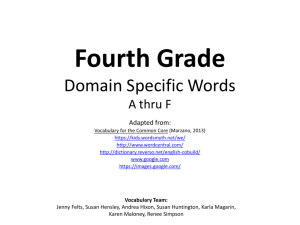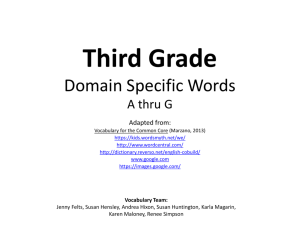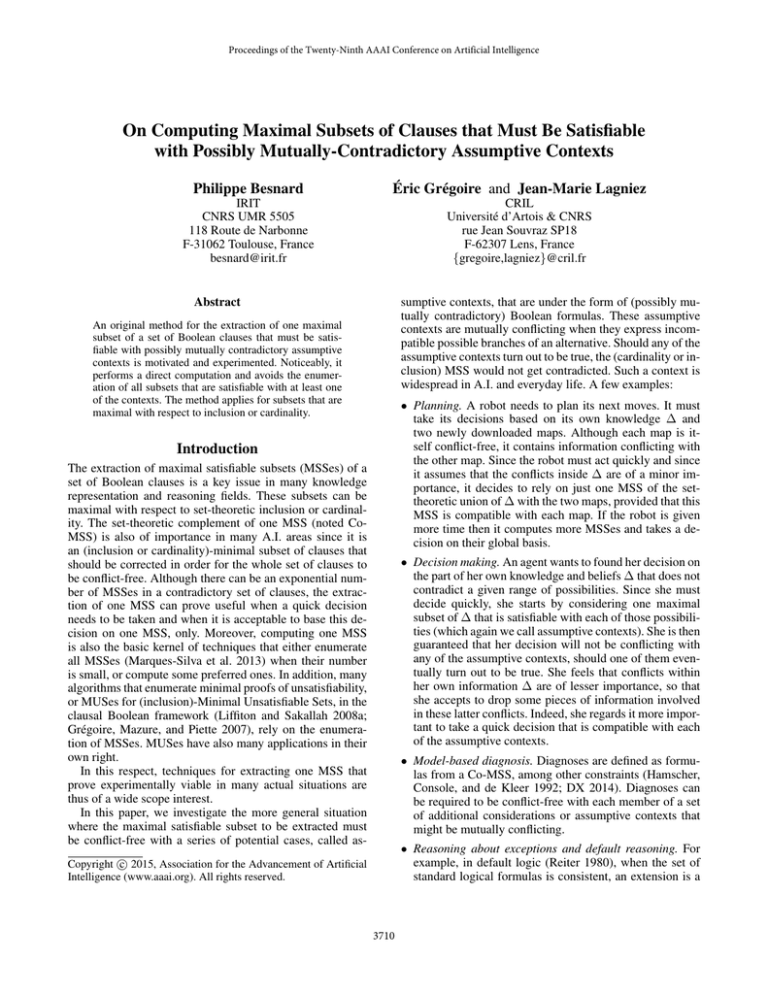
Proceedings of the Twenty-Ninth AAAI Conference on Artificial Intelligence
On Computing Maximal Subsets of Clauses that Must Be Satisfiable
with Possibly Mutually-Contradictory Assumptive Contexts
Philippe Besnard
Éric Grégoire and Jean-Marie Lagniez
IRIT
CNRS UMR 5505
118 Route de Narbonne
F-31062 Toulouse, France
besnard@irit.fr
CRIL
Université d’Artois & CNRS
rue Jean Souvraz SP18
F-62307 Lens, France
{gregoire,lagniez}@cril.fr
Abstract
sumptive contexts, that are under the form of (possibly mutually contradictory) Boolean formulas. These assumptive
contexts are mutually conflicting when they express incompatible possible branches of an alternative. Should any of the
assumptive contexts turn out to be true, the (cardinality or inclusion) MSS would not get contradicted. Such a context is
widespread in A.I. and everyday life. A few examples:
An original method for the extraction of one maximal
subset of a set of Boolean clauses that must be satisfiable with possibly mutually contradictory assumptive
contexts is motivated and experimented. Noticeably, it
performs a direct computation and avoids the enumeration of all subsets that are satisfiable with at least one
of the contexts. The method applies for subsets that are
maximal with respect to inclusion or cardinality.
• Planning. A robot needs to plan its next moves. It must
take its decisions based on its own knowledge ∆ and
two newly downloaded maps. Although each map is itself conflict-free, it contains information conflicting with
the other map. Since the robot must act quickly and since
it assumes that the conflicts inside ∆ are of a minor importance, it decides to rely on just one MSS of the settheoretic union of ∆ with the two maps, provided that this
MSS is compatible with each map. If the robot is given
more time then it computes more MSSes and takes a decision on their global basis.
Introduction
The extraction of maximal satisfiable subsets (MSSes) of a
set of Boolean clauses is a key issue in many knowledge
representation and reasoning fields. These subsets can be
maximal with respect to set-theoretic inclusion or cardinality. The set-theoretic complement of one MSS (noted CoMSS) is also of importance in many A.I. areas since it is
an (inclusion or cardinality)-minimal subset of clauses that
should be corrected in order for the whole set of clauses to
be conflict-free. Although there can be an exponential number of MSSes in a contradictory set of clauses, the extraction of one MSS can prove useful when a quick decision
needs to be taken and when it is acceptable to base this decision on one MSS, only. Moreover, computing one MSS
is also the basic kernel of techniques that either enumerate
all MSSes (Marques-Silva et al. 2013) when their number
is small, or compute some preferred ones. In addition, many
algorithms that enumerate minimal proofs of unsatisfiability,
or MUSes for (inclusion)-Minimal Unsatisfiable Sets, in the
clausal Boolean framework (Liffiton and Sakallah 2008a;
Grégoire, Mazure, and Piette 2007), rely on the enumeration of MSSes. MUSes have also many applications in their
own right.
In this respect, techniques for extracting one MSS that
prove experimentally viable in many actual situations are
thus of a wide scope interest.
In this paper, we investigate the more general situation
where the maximal satisfiable subset to be extracted must
be conflict-free with a series of potential cases, called as-
• Decision making. An agent wants to found her decision on
the part of her own knowledge and beliefs ∆ that does not
contradict a given range of possibilities. Since she must
decide quickly, she starts by considering one maximal
subset of ∆ that is satisfiable with each of those possibilities (which again we call assumptive contexts). She is then
guaranteed that her decision will not be conflicting with
any of the assumptive contexts, should one of them eventually turn out to be true. She feels that conflicts within
her own information ∆ are of lesser importance, so that
she accepts to drop some pieces of information involved
in these latter conflicts. Indeed, she regards it more important to take a quick decision that is compatible with each
of the assumptive contexts.
• Model-based diagnosis. Diagnoses are defined as formulas from a Co-MSS, among other constraints (Hamscher,
Console, and de Kleer 1992; DX 2014). Diagnoses can
be required to be conflict-free with each member of a set
of additional considerations or assumptive contexts that
might be mutually conflicting.
• Reasoning about exceptions and default reasoning. For
example, in default logic (Reiter 1980), when the set of
standard logical formulas is consistent, an extension is a
c 2015, Association for the Advancement of Artificial
Copyright Intelligence (www.aaai.org). All rights reserved.
3710
ering two formulas γ1 and γ2 of Γ, whereas it is actually
enough to drop one clause, only. An illustration of this phenomenon is Example 2 below. Clearly, this drawback holds
for both cardinality and inclusion-maximal MSSes. A natural but highly intractable solution to this problem requires
the following preliminary step: for each γ, compute every
inclusion-maximal MSS of ∆ that does not conflict with γ.
From this set of MSSes, compute the intended solution.
In this paper, we propose and investigate an approach that
avoids the computation of these intermediate MSSes and the
corresponding possible computational blow-up. To some extent, the approach pertains to the family of techniques that
ensure robust optimal solutions for all possible scenarios
(Ben-Tal, Ghaoui, and Nemirovski 2009).
maximal satisfiable set of formulas that, among other additional constraints, are satisfiable together with the socalled justifications of the generating default rules for the
extension. The non-commitment to assumptions property
(Delgrande, Schaub, and Jackson 1994) of Reiter’s default
logic expresses that extensions can be built from generating default rules with mutually conflicting justifications.
• Argumentation. In Dung’s seminal work on computational argumentation (Dung 1995), one logic-based interpretation of extensions is based on one MSS of a corresponding knowledge base (Vesic 2013). Also, in logicbased argumentation (Besnard and Hunter 2008), it has
been shown how arguments can be directly computed
from MSSes (Besnard et al. 2010). More generally, arguments can be required to be compatible with some additional pieces of information that might be mutually conflicting, like an argument showing that the defendant is
guilty and that is compatible with each of two cases: either the defendant is telling the truth or lying.
• Belief change. The extraction of maximal subsets of
beliefs that are satisfiable with some additional constraints corresponds to the so-called multiple contraction
(Fuhrmann and Hansson 1994) paradigm in belief change.
Note also that following Levi’s identity (Levi 1977), contraction is a basic building block of belief revision, too
(Fermé and Hansson 2011; Alchourrón, Gärdenfors, and
Makinson 1985): revising a deductive closed set of beliefs
by an incoming belief δ involves the contraction of the set
by the negation of δ, which is thus based on the extraction of MSSes that are satisfiable with δ, followed by an
expansion by δ, which includes deductive closure.
Preliminaries and Technical Background
We consider standard Boolean logic: let L be a language
of formulas over an alphabet P of Boolean variables, also
called atoms. Atoms are denoted by a, b, c, . . . The symbols ∧, ∨, ¬, ⇒ and ⇔ represent the standard conjunctive, disjunctive, negation, material implication and equivalence connectives, respectively. Formulas are built in the
usual way from atoms, connectives and parentheses; they
are denoted by α, β, γ, . . . Sets of formulas are denoted by
Φ, Γ, . . . The cardinality of a set of formulas Γ is written
card(Γ). A literal is an atom or a negated atom. A clause is a
disjunction of literals. A unit clause is formed of one literal.
A set of formulas Γ is satisfiable iff there exists at least
one model of ∆, namely a truth assignment of all atoms of
Γ making all formulas of Γ to be true according to usual
compositional rules. Any formula γ can be represented as a
set of clauses, denoted Clausal(γ), equivalent to γ with respect to satisfiability, that is obtained through usual standard
rewriting procedures.
SAT is the N P -complete problem that consists in checking whether a finite set of clauses is satisfiable.
From now on, we assume that ∆ is a finite set of clauses,
that Φ and Ψ are subsets of ∆ and that Γ is a finite set of
Boolean formulas, each of the formulas in Γ being (individually) satisfiable. As a shortcut, γ will be identified with
Clausal(γ) for γ ∈ Γ.
In view of these applications, the contribution of this paper is as follows. We introduce and experimentally investigate a method to compute one maximal subset of a set
of Boolean clauses ∆ such that this subset is satisfiable
with each member of a set of possibly mutually conflicting Boolean formulas Γ. Actually, it is not a straightforward
issue to transform an experimentally efficient method that
computes one MSS into a practical technique that extracts
one maximal satisfiable subset that is compatible with each
member of Γ. Let us elaborate on this.
Assume first that (1) we have selected an experimentally efficient algorithm that computes one MSS of a set of
Boolean clauses ∆, (2) we are given an unsatisfiable set of
of Boolean formulas Γ that represents a set of assumptive
contexts that are mutually conflicting, (3) formulas from Γ
can contradict ∆ and (4) ∆ can be unsatisfiable. Let us write
Clausal(γ) for a set of clauses, equivalent to γ with respect to
satisfiability, that is obtained through usual standard rewriting procedures.
One naive method would be as follows: for each γ ∈
Γ, compute one MSS of ∆ ∪ {Clausal(γ)} that contains
Clausal(γ) and its corresponding
Co-MSS, which we denote
S
Ψγ . Clearly, ∆∗ = ∆ \ γ∈Γ {Ψγ } is satisfiable with every
formula γ of Γ. However, ∆∗ is not necessarily an intended
solution since there might exist a strict superset of ∆∗ that
is also satisfiable with every formula of Γ. Indeed, we might
have dropped two different clauses from ∆ when consid-
Definition 1. Φ is an inclusion-Maximal Satisfiable Subset
of ∆, in short, Φ is an MSS⊆ (∆), iff Φ is satisfiable and
∀α ∈ ∆ \ Φ, Φ ∪ {α} is unsatisfiable.
Definition 2. Φ is a cardinality-Maximal Satisfiable Subset
of ∆, in short, Φ is an MSS# (∆), iff Φ is an MSS⊆ (∆) and
@Φ0 s.t. Φ0 is an MSS⊆ (∆) and card(Φ) < card(Φ0 ).
A Co-MSS of ∆ is the set-theoretic complement in ∆
of the corresponding MSS. For ease of notation, we write
(Co-)MSS instead of (Co-)MSS⊆ and (Co-)MSS# , when
the context does not make this ambiguous or when no such
distinction is necessary.
Definition 3. Ψ is a Minimal Correction Subset (MCS or
Co-MSS) of ∆ iff Ψ = ∆ \ Φ where Φ is an MSS of ∆.
Accordingly, ∆ can always be partitioned into a pair made
of one MSS⊆ and one Co-MSS⊆ . Unless P = N P , extracting one such partition is intractable in the worst case since it
3711
belongs to the F P N P [wit, log] class, i.e., the set of function
problems that can be computed in polynomial time by executing a logarithmic number of calls to an N P oracle that
returns a witness for the positive outcome (Marques-Silva
and Janota 2014). Techniques to compute one such partition
that prove very often efficient are described in (Grégoire,
Lagniez, and Mazure 2014; Marques-Silva et al. 2013). Note
that in the worst case the number of MSSes is exponential in
the number of clauses in ∆.
The instance of the Max-SAT problem w.r.t. ∆ consists
in delivering the cardinality of any MSS# (∆). In the following, we consider the variant of Max-SAT that not only
delivers this cardinality but also one such MSS# (∆). We
also make use of the following variant definition of PartialMax-SAT.
Definition 4. Let Σ1 and Σ2 be two sets of clauses. PartialMax-SAT(Σ1 , Σ2 ) computes one cardinality maximal subset of Σ1 that is satisfiable with Σ2 . Σ1 and Σ2 are called
the sets of soft and hard constraints, respectively.
These variants of (Partial-)Max-SAT belong to the Opt −
P class of problems (Papadimitriou and Yannakakis 1991),
namely the class of functions computable by taking the maximum of the output values over all accepting paths of an N P
machine.
Indeed, even when the assumptions are not logically mutually conflicting by themselves, they interact with ∆ and
this influences AC-MSS(∆, Γ). To circumvent this issue, as
is mentioned in the introduction, it would be tempting to extract for each γ ∈ Γ one MSS(∆ ∪ {γ}) that contains
γ; let
S
Ψγ be the corresponding Co-MSS. Although ∆\ γ∈Γ {Ψγ }
is satisfiable with every formula γ of Γ, it is not guaranteed
to be an AC-MSS(∆, Γ), even when Γ is satisfiable.
Example 2. Let ∆ = {¬a ∨ b, ¬b, d} and Γ = {a, b}. Γ
is satisfiable. There are two MSS(∆ ∪ {a}) that contain
the subset {a}, namely {¬a ∨ b, d, a} and {¬b, d, a} and
one MSS(∆ ∪ {b}) that contains the subset {b}, namely
{¬a ∨ b, d, b}. Clearly, when {¬b,S
d, a} is extracted as one
MSS(∆ ∪ {a}), we have that ∆ \ γ∈Γ {Ψγ } (where Ψγ is
the Co-MSS corresponding to the selected MSS(∆ ∪ {γ}))
yields {d}. However, {d} is not an AC-MSS(∆, Γ); there is
a unique AC-MSS(∆, Γ), i.e., {¬a ∨ b, d}.
When Γ is unsatisfiable, this needs not prevent ACMSS(∆, Γ) from existing.
Example 3. Let ∆ = {¬a ∨ b, ¬b, d} and Γ = {a, b, ¬a}.
{¬a ∨ b, d} is the unique AC-MSS(∆, Γ).
The correct direct (brute-force) approach to extract one
AC-MSS(∆, Γ) is thus as follows. First, for every γ ∈ Γ
enumerate all MSS⊆ (∆ ∪ {γ}) that contain γ. Then, select
one corresponding Co-MSS
⊆ (∆ ∪ {γ}) per γ , denoted Ψγ ,
S
such that ∆∗ = ∆ \ γ∈Γ {Ψγ } exhibits the largest cardinality (when AC-MSS# is under consideration) or such that
∆∗ is inclusion-maximal (for AC-MSS⊆ ). ∆∗ is the result.
Since there can be an exponential number of MSSes in a
set of clauses, the direct approach is intractable in the worst
case, and, as our experimentations will illustrate, in many
expectedly-easier situations.
Problem Statement and Basic Examples
In this paper, we are interested in maximal satisfiable subsets
that are computed under a set of assumptive contexts.
Definition 5. Φ is an inclusion-Maximal Satisfiable Subset
of ∆ under a set of assumptive contexts Γ, (Φ is an ACMSS⊆ (∆, Γ) for short), iff
1. Φ is a satisfiable subset of ∆, and
2. ∀γ ∈ Γ, Φ ∪ {γ} is satisfiable, and
3. ∀α ∈ ∆ \ Φ, Φ ∪ {α, γ} is unsatisfiable for some γ ∈ Γ.
Definition 6. Φ is an AC-MSS# (∆, Γ) iff Φ is an ACMSS⊆ (∆, Γ) and @Φ0 s.t. Φ0 is an AC-MSS⊆ (∆, Γ) and
card(Φ) < card(Φ0 ).
The extraction of one AC-MSS(∆, Γ) is the addressed
problem in this paper. Note that, as is illustrated in the example about the robot that needs to handle two incoming contradictory maps, it is sometimes required to extract one ACMSS(∆, Γ) where Γ ⊆ ∆. Also notice that the elements of
Γ are used in a pointwise manner: any AC-MSS(∆, Γ) must
be satisfiable together with any γ, taken individually. This
expresses the requirement that each γ represents an assumptive context and that the conjunction of all the assumptive
contexts of Γ is not required to be satisfiable.
Let us give very basic examples showing the difficulty in
the use of the computation of MSS(∆) to extract one ACMSS(∆, Γ). First, assume that Γ is satisfiable: this occurs
when the assumptive contexts are not conflicting. Even in
this simple case, we cannot consider all elements of Γ conjunctively and interpret them as forming one unique global
constraint of consistency that must be respected, as the following simple counter-example illustrates.
Example 1. ∆ = {a ∨ b, d}. AC-MSS(∆, {¬a, ¬b}) = ∆
but AC-MSS(∆, {¬a ∧ ¬b}) = {d}.
A Transformational Method
On the contrary, we propose an approach that avoids the extraction of these intermediate Co-MSSes and make a direct
global extraction of one AC-MSS(∆, Γ) in all cases. To this
end, both ∆ and Γ are transformed into two other sets of
clauses and a new (but equivalent) problem is generated.
We shall make use, among other things, of an algorithm
that extracts one MSS⊆ (∆) that is satisfiable with the conjunction of the elements of another set of clauses, when
this latter set is satisfiable. Such an algorithm is easily derived from the CMP method from (Grégoire, Lagniez, and
Mazure 2014) or any procedure described in (MarquesSilva et al. 2013). For convenience purpose, the notation
Extract-MSS(Σ1 , Σ2 ) where Σ1 and Σ2 are two sets of
clauses will be used to represent either this algorithm, or,
when cardinality-maximal subsets are under consideration,
Partial-Max-SAT(Σ1 ,Σ2 ).
Our method makes one call to Extract-MSS, only. It is insensitive to whatever ordering of formulas from Γ or ∆, and
builds the set of hard constraints Σ2 to be a satisfiable set.
In addition, the following seemingly contradictory features
also need to be accommodated together, among other things.
On the one hand, each formula γ of Γ need be treated separately from the other formulas from Γ to ensure that the
3712
resulting MSS is satisfiable with γ. Hence, this treatment is
local (i.e., performed with respect to γ). On the other hand,
this local decision has a global impact on the problem since
it impacts the satisfiability of the remaining part of ∆ with
other γ’s. The method satisfies these local and global requirements: it is based on following ideas.
First, note that whenever γ is satisfiable with ∆, γ is satisfiable with any subset of ∆ and thus with any MSS of
∆: hence, no clause needs to be dropped from ∆ in the local process that ensures that the extracted MSS is satisfiable with γ. In the following, we consider only γ’s such that
∆ ∪ {γ} is unsatisfiable.
For each γ, the extraction of one maximal subset of
clauses that is satisfiable with γ is rewritten as an independent sub-problem. To this end, for each γ, a corresponding
set of clauses ∆∪{γ} is created; all its variables are renamed
through the use of fresh atoms. All sub-problems are then
linked together as follows, adopting one arbitrary ordering
between clauses in ∆. An atom i is created and associated
to each clause δi from ∆. More precisely, each clause δ from
∆ in every sub-problem (i.e., ∆∪{γ} that has been renamed
using fresh variables), gets the additional disjunct ¬i when
δ corresponds to δi in ∆. Now, all these ∆ ∪ {γ} endowed
with the additional disjuncts will form the hard consistency
constraints, i.e., the second parameter in the unique call to
Extract-MSS. The set consisting of all these clauses is satisfiable (just set every i to false). Secondly, the set of unit
clauses {i s.t. i ∈ [1..n]} forms the soft constraints, i.e., the
first parameter in the unique call to Extract-MSS. Whenever
a clause i from this set does not belong to the MSS that is
extracted, δi from ∆ does not belong to the (global) computed AC-MSS. Indeed, this means that some clause within
the hard constraints that contains the disjunct ¬i actually
requires ¬i to be true, and the corresponding clause is not
to be a member of the AC-MSS under construction.
The Transformational Approach algorithm that is depicted below implements this idea. In line 1, the set Σ1 of
soft clauses is created: it is the set of positive unit clauses i ,
called selectors, that are created for every clause δi ∈ ∆. In
line 2, the set of hard clauses Σ2 is initialized to the empty
set. Σ2 will gather the sub-problems. In line 3, a copy of ∆ is
created where each clause is weakened by the negation of its
corresponding selector i . This copy is called ∆0 . Whenever
γj contradicts ∆ (l. 4), ∆0 ∪{γj } has all its variables (except
the i ) renamed (l. 6), thereby representing the sub-problem
Φj devoted to finding an MSS satisfiable with γj (l. 4-7). All
sub-problems are collected in a single set that forms Σ2 (l.
7).
Notice that when every γ is satisfiable with ∆, Σ2 is
empty and ∆ is delivered as result; this situation can occur independently of Γ being satisfiable or not. Otherwise (l.
9), an MSS of Σ1 that satisfies all the clauses of the global
problem Σ2 is delivered in Ψ by the call to Extract-MSS.
The final result is the set of all clauses δi of ∆ for which
the corresponding clause i belongs to the set Ψ (which is
the output of the single call to Extract-MSS). Let m be the
number of different formulas in Γ, n0 the largest number of
clauses encoding one formula of Γ, n the number of clauses
in ∆.
Transformational Approach
1
2
3
4
5
6
7
input : ∆ = {δ1 , . . . , δn }: a set of n Boolean clauses;
Γ = {γ1 , . . . , γm }: a set of m satisfiable Boolean formulas;
output: one AC-MSS(∆, Γ)
/* Σ1 will be the set of soft clauses
Σ1 ← {i s.t. i ∈ [1..n]} /* every i is a fresh new atom
/* Σ2 will be the set of hard clauses
Σ2 ← ∅;
∆0 ← {δi ∨ ¬i s.t. δi ∈ ∆};
foreach γj ∈ Γ s.t. UNSAT(∆ ∪ {γj }) do
/* Φj is the sub-problem related to γj
Φj ← ∆0 ∪ {γj } ;
Rename all atoms in Φj (except the i ) with fresh new atoms;
Σ2 ← Σ2 ∪ Φj ;
*/
*/
*/
*/
8 if Σ2 6= ∅ then
9
Ψ ← Extract-MSS(Σ1 ,Σ2 );
10
∆ ← {δi s.t. δi ∈ ∆ and i ∈ Ψ};
11 return (∆);
Property 1. The Transformational Approach computes one
AC-MSS(∆, Γ).
Property 2. The Transformational Approach requires m
calls to a SAT solver on an instance of size O(n + n0 ), plus
one call to Extract-MSS with a set of hard constraints of consistency of size O(m(n + n0 )) and a set of soft constraints
of size O(n).
From a worst-case complexity analysis, an approach that
computes all MSS for each γ as one step of the construction
of one AC-MSS(∆, Γ) is clearly intractable since the number of MSS of a set of clauses can be exponential in the number of clauses in the set. Property 2 allows the worst-case
complexity of the transformational method to be derived.
For example, when Extract-MSS is related to MSS⊆ computation, the method requires O(m) calls to a SAT-solver
on an instance of size O(n + n0 ), plus a logarithmic number of calls to a SAT-solver on an instance of initial size
O(m(n + n0 )) that is divided by two at each call.
Formal Specification
Formally, the transformational method can be defined as follows.
Selectors: Let (i )i=1,...,card(∆) be a family of Boolean variables extracted from P \ Atom(∆ ∪ Γ)
Copy substitutions: A family of substitutions
(µj )j=1,...,card(Γ) , each with domain Atom(∆ ∪ Γ)
and codomain P \ Atom(∆ ∪ Γ), are defined such that
- Image(µj ) ∩ {i | i = 1, . . . , card(∆)} = ∅ for j =
1, . . . , card(Γ)
- Image(µh ) ∩ Image(µk ) = ∅ whenever h 6= k
Copies: For j = 1, . . . , card(Γ), let
def
Φj = {µj δi ∨ ¬i | i = 1, . . . , card(∆)} ∪ {µj γj }
Problem: ExtractMSS(Σ1 , Σ2 ) where
- Σ1 = {i | i = 1, . . . , card(∆)}
3713
- Σ2 =
S
j=1,...,card(Γ)
Φj
assumptive contexts, namely 10. We considered the worstcase situation with respect to the grow of the instance size
that is encountered through the transformation: this occurs
when every formula γ conflicts with ∆. We have also selected each γ as a set of non-unit clauses that can be proved
satisfiable in a very short time, following the hypothesis
that assumptive contexts are easily shown satisfiable but are
not necessarily mere unit clauses. More precisely, each γ
has been generated as follows. An unsatisfiable 3-SAT instance, i.e., an unsatisfiable set of ternary clauses Φ was
randomly generated after the satisfiability/unsatisfiability
threshold, using the variables occurring in clauses in ∆ representing the initial state. To this end, we used the standard clauses generator from WALKSAT Version 51 (http:
//www.cs.rochester.edu/∼kautz/walksat/). Accordingly, the γ’s
are intended to represent a series of possibly conflicting information about the initial state. Φ was then partitioned into
m subsets of clauses, each of them forming the seed to build
one assumptive context γ. Each seed was then augmented
with additional random binary clauses until it became unsatisfiable with ∆ and thus formed the intended γ. This was
done in such a way that γ remains satisfiable. Accordingly,
each γ is one satisfiable set of clauses that is unsatisfiable
with ∆ and the set Γ = {γ1 , . . . , γm } is itself unsatisfiable.
We believe that this generation model provides γ’s that
can capture reasonably complex items in the target domain.
For Ω satisfiable, ExtractMSS(Θ, Ω) is supposed to be such
that its output is both a maximal satisfiable subset of Θ ∪ Ω
and a superset of Ω.
Experimental Study
The goal of the experimental study was to investigate the
actual viability of the transformational approach.
Benchmarks from the planning area as a case study. We
have considered 225 instances of usual benchmarks from
the planning area as a case study. Let us stress that we do
not solve the planning problem in the experimentations. All
we do is “filter” the planning instances so that they become
consistent with each assumptive context. We handled the instances as mere sets of clauses and we did not assign initial and final states their whole specific roles, since these
concepts are not relevant to the other potential application
domains. If we want to apply the approach in the planning
domain up to computing plans then it would make sense to
slightly adapt the framework so that initial and final states,
fluents, etc. do match their full epistemological roles. For
example, when a goal (final state) contradicts an assumptive context, the user might be asked whether or not she (he)
would accept the goal to be transformed so that it becomes
consistent with each of these contexts. The benchmarks ∆
represent the domain knowledge, as well as the initial and
goal states. For example, ∆ can represent the environment
in which a robot is moving, as well as its initial and goal
states, whereas Γ translates some additional assumptive information: for example γ1 is indicating that the energy level
of the robot is too low to reach a target whereas γ2 asserts
the contrary.
The instances cover a wide range of planning problems with varying horizon lengths. For example,
“Blocks right x” refers to the usual blocks-world problem
involving x blocks. “Bomb bx by” is the similar information for the problem of neutralizing bx bombs in by
locations. “Coins px” is about px coins that need to be
tossed for heads and tails so that they all reach the same
state. “Comm px” corresponds to an IPC5 problem about
communication signals with several stages, packets, and
actions. “Empty-room dx dy” is about a robot navigating
in a room of size dx and containing dy objects. “Safe n”
is about opening a safe with n possible combinations.
“sort num s x” is about building circuits of compare-andswap gates to sort x Boolean variables. “uts kx” is about a
network routing problem for mobile ad-hoc networks where
a broadcast from an unknown node must reach all nodes; the
topology of the network is partially known and each node in
the graph has a fixed number kx of connected neighbors.
Each ∆ was translated into clausal normal form from its
initial PDDL 1.2 (Planing Domain Definition Language)
and STRIPS format, using H. Palacios’ translator, available
from http://www.plg.inf.uc3m.es/∼hpalacio/.
Hardware, software and time-out. All experimentations have been conducted on Intel Xeon E5-2643
(3.30GHz) processors with 8Gb RAM on Linux CentOS. Time limit was set to 60 minutes per test. All
experimentation data, as well as our developed methods, are available from http://www.cril.fr/AAAI15-BGL.
For the inclusion-maximal case, we have adapted the
CMP method from (Grégoire, Lagniez, and Mazure
2014) in such a way that it implements Extract-MSS.
We have used C AMUS (Liffiton and Sakallah 2008b)
http://sun.iwu.edu/∼mliffito/camus/ to enumerate all MSS⊆ and
Co-MSS⊆ . MSU N C ORE (Morgado, Heras, and MarquesSilva 2012) http://logos.ucd.ie/wiki/doku.php?id=msuncore
and M INI SAT (Eén and Sörensson 2004) http://minisat.se/
were selected as the Partial-Max-SAT and SAT solvers,
respectively.
Table 1 provides a sample of results (the results for the 225
instances tested for each value of |Γ| ∈ {2, 3, 5, 10} are
available from http://www.cril.fr/AAAI15-BGL). All times are
in seconds, rounded down to the immediate strictly lower
integer. In the first column, the instance name is given, followed by the size of ∆ in terms of the number of its variables
(#V ars) and clauses (#Clauses), successively. The names
of the instance are postfixed with the planning horizon, written p tx, as “planning problem with tx steps as horizon”.
The following parameters about Γ are then listed successively: first, the number of variables in Γ (#V ar), which
are all the variables from ∆ used to encode the initial state
of the planning problem. Then, the number of formulas (|Γ|)
and the average size of the γ’s (avg |γ|) in terms of their
number of clauses are given. Then the table provides the
Generation of the assumptive contexts. We have experimented the method with a reasonable maximal value m of
3714
Γ
Brute force
Transformed Inst. AC-MSS⊆ Tr. Meth. AC-MSS# Tr. Meth.
#Var |Γ| avg|γ| status T avg|#coM ss| #var #hard #soft status
T
#rm status T
#rm
236 MO ?
?
0
78 OK 453
43
67 2
2715 3806 1903 OK
78 OK 61
9433
443 OK
0
6 OK 0
5
66 10
2843 4430
1757 MO ?
?
2
6 OK 2007
4
500 2
3870 3740 1870 OK
112 10
6779 14190 1419 OK
83 MO ?
?
0
8 OK 0
4
157 MO ?
?
951 OK
0
28 OK 840
11
112 5
2791 4755
157 MO ?
?
0
16 OK 63
10
112 5
6715 11775 2355 OK
coins p03 p t5 (872 2355)
112 10
85 MO ?
?
11075 23550 2355 OK
0
10 OK 2
6
157 MO ?
?
951 OK
0
12 OK 196
9
coins p05 p t2 (368 951)
112 5
2791 4755
140 MO ?
?
0
9 OK 5
6
comm p02 p t2 (555 1623)
189 10
7173 16230 1623 OK
1786 MO ?
?
1
361 MO ?
?
510 2
19035 24534 12267 OK
comm p05 p t5 (3384 12267)
366 MO ?
?
0
15 OK 72
6
510 10
46107 122670 12267 OK
22 OK 922
37875
1300
130 OK
0
9 OK 0
5
emptyroom d4 g2 p t1 (44 130) 32 10
570
51 MO ?
?
778 OK
0
21 OK 97
7
emptyroom d8 g4 p t3 (244 778) 72 10
3218 7780
ring2 r6 p t1 (76 215)
54 10
975
38 MO ?
?
2150
215 OK
0
17 OK 11
8
ring2 r6 p t2 (134 402)
54 2
670
190 MO ?
?
804
402 OK
0
54 OK 0
26
164 MO ?
?
726
242 OK
0
32 OK 148
12
ring 5 p t1 (114 242)
70 3
584
75 OK 635
69924
714
357 OK
0
24 OK 0
5
safe safe 10 p t5 (166 357)
21 2
689
safe safe 30 p t5 (486 1347)
61 10
43 MO ?
?
6207 13470 1347 OK
0
82 OK 44
17
sort num s 3 p t1 (39 106)
27 2
184
96 MO ?
?
212
106 OK
0
19 OK 0
10
30 MO ?
?
400 OK
0
12 OK 0
8
sort num s 3 p t4 (129 400)
27 10
1690 4000
62 MO ?
?
0
21 OK 3353
10
sort num s 4 p t5 (486 1810)
88 10
6670 18100 1810 OK
925 MO ?
?
0
350 MO ?
?
sort num s 6 p t2 (858 3509)
396 3
6083 10527 3509 OK
40 OK 337
29328
1020
204 OK
0
8 OK 0
7
uts k1 p t2 (71 204)
25 5
559
uts k2 p t5 (530 1903)
81 10
7203 19030 1903 OK
57 MO ?
?
0
20 OK 1114
13
118 MO ?
?
0
46 MO ?
?
uts k3 p t3 (682 2695)
169 10
9515 26950 2695 OK
Instance
Name (#Vars #Clauses)
blocks right 2 p t5 (406 1903)
bomb b5 t1 p t2 (240 443)
bomb b10 t10 p t1 (1000 1870)
coins p01 p t3 (536 1419)
coins p03 p t2 (368 951)
Table 1: Sample of Results. The full table can be found at http://www.cril.fr/AAAI15-BGL
needed more than 2 seconds, namely 4.54 and 2.41 seconds).
Not surprisingly, applying an additional minimal-cardinality
constraint in order to yield one AC-MSS# proved less often feasible. However, 415/900 instances were successfully
solved in this way. For example, the bomb b10 t1 p t2 instance involves 1870 clauses and 1000 Boolean variables: it
yielded the second slowest run-time (2.41 seconds) for the
computation of one AC-MSS⊆ . Γ was built by using the
500 variables occurring in the description of the initial state
of the planning problem, giving rise to two formulas, each
of them encoded through 1757 clauses on average. Note that
in this respect each γ is intended to represent a very elaborate assumptive context for the concerned planning problem. The ratio #hard/#Clauses= 2 since the two γ’s were
built so that they were both contradictory with ∆. The tentative enumeration of all Co-MSSes led to memory overflow.
The transformed instance is made of 3740 hard and 1870
soft clauses, making use of 3870 variables. The transformational method that extracted one AC-MSS# required 2007
seconds to be completed (including the transformation step),
ending with a guaranteed minimal number of 4 clauses to be
rejected from the initial instance. The method that extracted
one AC-MSS⊆ rejected two additional clauses but was very
fast (2.41 seconds rounded down to 2 in Table 1).
The real-time performance reached in the experimentations should be interpreted as a positive point: the experimental conditions that allow for these results are reasonable
and possibly widespread even outside the planning field. Especially, the number and size of assumptive contexts and the
limited size of the computed Co-MSSes are all important
criteria: relaxing any of them can lead to possible performance degradation. Finally, we believe that although all the
experimental results for the first step of the “brute force”
method, which extracts for every γ all Co-MSS⊆ (∆ ∪ {γ})
that do not contain γ. The columns list the status of this
step (“OK”, or “MO” for memory-out) and the time (“T”)
to run the method and the average number of computed
Co-MSSes (avg |#CoM SS|) for each γ. When memory
out happened due to combinatorial blow-up, no information about these two parameters could be delivered (hence,
the “?” in the columns). Results about the transformational
methods are provided next. Firstly, the main parameters of
the transformed problem are given, namely the number of
variables in the transformed problem, the number of clauses
of this latter one split between the clauses that are intended
to play the role of hard clauses (#hard) and soft clauses
(#soft), respectively. Secondly, results about computing one
AC-MSS⊆ are given: for every successfully solved instance
(status = “OK”), we list the global time to complete the
transformational method (including the call to Extract-MSS)
and the number of (#rm) clauses that are dropped from ∆
to yield the extracted AC-MSS⊆ . Thirdly, the last columns
give the same main parameters when one AC-MSS# (∆, Γ)
was to be extracted.
Discussion. As expected, the brute force method to extract one AC-MSS⊆ (or one AC-MSS# ) faced computational blow-up most of the times: the full list of intermediate Co-MSSes was delivered for only 81/900 problem
instances within the 1 hour computation allocated per instance. Not surprisingly, the transformational method that
extracts one AC-MSS⊆ outperformed the brute force one:
all the instances (i.e., 900/900) were solved successfully,
and the average time to compute one AC-MSS was 0.05 second, reaching real-time performance (only 2/900 instances
3715
tested instances are related to the same generic domain (i.e.,
planning), these criteria about the “logical structure” of the
instances are also relevant to other potential application domains.
Fermé, E. L., and Hansson, S. O. 2011. AGM 25 years - twentyfive years of research in belief change. Journal of Philosophical
Logic 40(2):295–331.
Fuhrmann, A., and Hansson, S. O. 1994. A survey of multiple contractions. Journal of Logic, Language, and Information
3(1):39–75.
Grégoire, É.; Lagniez, J.-M.; and Mazure, B. 2014. An experimentally efficient method for (MSS,CoMSS) partitioning.
In Proceedings of the 28th Conference on Artificial Intelligence
(AAAI’14).
Grégoire, É.; Mazure, B.; and Piette, C. 2007. Boosting a complete technique to find MSS and MUS thanks to a local search
oracle. In Proceedings of the 20th International Joint Conference on Artificial Intelligence (IJCAI’07), 2300–2305.
Hamscher, W.; Console, L.; and de Kleer, J., eds. 1992. Readings in model-based diagnosis. Morgan Kaufmann.
Levi, I. 1977. Subjunctives, dispositions and chances. Synthese
34:423–455.
Liffiton, M. H., and Sakallah, K. A. 2008a. Algorithms for
computing minimal unsatisfiable subsets of constraints. Journal
of Automated Reasoning 40(1):1–33.
Liffiton, M., and Sakallah, K. 2008b. Algorithms for computing minimal unsatisfiable subsets of constraints. Journal of
Automated Reasoning 40(1):1–33.
Marques-Silva, J., and Janota, M. 2014. On the query complexity of selecting few minimal sets. Electronic Colloquium
on Computational Complexity (ECCC) 21:31.
Marques-Silva, J.; Heras, F.; Janota, M.; Previti, A.; and Belov,
A. 2013. On computing minimal correction subsets. In Proceedings of the 23rd International Joint Conference on Artificial Intelligence (IJCAI’13).
Morgado, A.; Heras, F.; and Marques-Silva, J. 2012. Improvements to core-guided binary search for MaxSAT. In Proceedings of the 15th International Conference on Theory and Applications of Satisfiability Testing (SAT’12), volume 7317 of Lecture Notes in Computer Science, 284–297. Springer.
Papadimitriou, C. H., and Yannakakis, M. 1991. Optimization,
approximation, and complexity classes. Journal of Computer
and System Sciences 43(3):425 – 440.
Reiter, R. 1980. A logic for default reasoning. Artificial Intelligence 13(1-2):81–132.
Vesic, S. 2013. Identifying the class of maxi-consistent operators in argumentation. Journal of Artificial Intelligence Research (JAIR) 47:71–93.
Conclusion and Perspectives
We believe that the results in this paper could open various
promising paths for further research. Firstly, as motivated
in the introduction, the technique from this paper could be
exported to the specific settings of various relevant A.I. subfields and problems, which might however require additional
technical developments. Secondly, as the method circumvents the possibly exponential number of MSSes and of CoMSSes, it might be fruitful to explore to which extent this
can prove useful in the practical handling of other problems
that usually rely on the enumeration of these latter sets, like
the enumeration of MUSes (Minimal Unsatisfiable Subsets).
Finally, the additional minimization required by the extraction of cardinality-maximal AC-MSS entails some significant computational overhead: in view of the better performance of the computation of one AC-MSS⊆ in practical situations, it might be worth defining and investigating strategies for the approximation of one AC-MSS# through the
guided computation and handling of several AC-MSS⊆ .
Acknowledgments
The authors are grateful to the reviewers for their useful
comments and they are indebted to B. Mazure for discussions on the topics of this paper.
References
Alchourrón, C. E.; Gärdenfors, P.; and Makinson, D. 1985. On
the logic of theory change: Partial meet contraction and revision
functions. Journal of Symbolic Logic 50(2):510–530.
Ben-Tal, A.; Ghaoui, L. E.; and Nemirovski, A. 2009. Robust
Optimization. Princeton University Press.
Besnard, P., and Hunter, A. 2008. Elements of Argumentation.
MIT Press.
Besnard, P.; Grégoire, É.; Piette, C.; and Raddaoui, B. 2010.
MUS-based generation of arguments and counter-arguments. In
Proceedings of the IEEE International Conference on Information Reuse and Integration (IEEE IRI’10), 239–244.
Delgrande, J. P.; Schaub, T.; and Jackson, W. K. 1994. Alternative approaches to default logic. Artificial Intelligence 70(12):167–237.
Dung, P. M. 1995. On the acceptability of arguments and its
fundamental role in nonmonotonic reasoning, logic programming and n-person games. Artificial Intelligence 77(2):321–
358.
DX. 2014. 25th International Workshop on Principles of
Diagnosis (DX’14). http://dx-2014.ist.tugraz.at/dx14 program
papers.html (on-line proceedings).
Eén, N., and Sörensson, N. 2004. An extensible SAT-solver. In
Proceedings of the 6th International Conference on Theory and
Applications of Satisfiability Testing (SAT’03). Selected Revised
Papers, volume 2919 of Lecture Notes in Computer Science,
502–518. Springer.
3716



